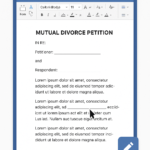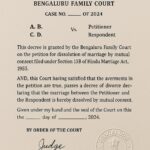Stepwise Process of Mutual Divorce
Below is the 7-step process for obtaining a mutual divorce from the family courts of Bangalore, Chennai, Delhi, Gurgaon, Hyderabad, Mumbai, Noida, and Pune.

Step 1: Apply for Divorce Online | Fee: ₹1,000
One spouse fills out our Mutual Divorce Online Form and pays the ₹1,000 fee. This initiates a confidential email to both parties asking them to confirm their decision to proceed. Both must reply with “Yes” to move forward. If both confirm, we guide them to discuss mutual settlement terms.

Step 2: Settlement Terms | Documents
Both parties provide the finalized, mutually agreed-upon terms (child custody, maintenance, property division) and all necessary documents (address proof, marriage proof, etc.) via email.

Step 3: Draft Mutual Divorce Petition | Fee: ₹9,000
Our expertise spans the family courts of Delhi, Noida, Mumbai, Gurugram, and Bengaluru. We understand the unique procedures of each jurisdiction. We will finalize your joint petition and all supporting affidavits, meticulously incorporating your agreed terms and ensuring all necessary documents are correctly prepared for filing.

Step 4: First Motion Hearing in Court | Fee: ₹15,000 (₹25,000 for NRIs)

Step 5: Cooling off Period/Mediation/Counselling

Step 6: Second Motion Hearing in Court | Fee: ₹20,000 (₹25,000 for NRIs)

Step 7: Divorce Decree from Court
Shortly after the second motion hearing, the Family Court issues two certified divorce decrees—one for the husband and one for the wife. We promptly mail these to both parties upon receipt from the court. Alternatively, the parties may collect the decrees directly from our office.
Mutual Divorce Stepwise Process FAQ
The first step is that one spouse fills out our Mutual Divorce Application Form and pays the ₹1,000 fee. Once the form is submitted, we initiate a confidential email conversation with husband and wife within 12 hours. We first advise careful reconsideration. If both parties remain firm in their decision, we then guide them through discussing mutual settlement terms of divorce.
The mutual divorce terms and conditions are the agreements reached between the spouses regarding various aspects of their separation, such as Child Custody, maintenance, alimony, property division, and other relevant matters. These terms outline how the couple will manage their post-marital lives and responsibilities.
The divorcing spouses themselves need to decide these terms and conditions through mutual agreement. They negotiate and discuss each aspect, considering their individual needs and circumstances. Legal professionals or mediators may assist in facilitating these discussions and ensuring that the terms are legally sound and fair to both parties. Both spouses need to consent to the terms before they can be finalized and submitted to the court for approval. Once both parties are satisfied with the terms, they are documented in a legally binding agreement and presented to the court as part of the mutual divorce process.
It’s important to note that in a mutual divorce, the court’s involvement is generally limited to approving the terms and conditions that the spouses have agreed upon regarding Child Custody, maintenance, alimony, property division, and other relevant matters. The court’s role is to ensure that the agreed-upon terms are legally sound and in accordance with applicable laws. If the terms are fair and reasonable, the court is likely to approve them. However, if the court finds any terms to be unjust or against legal norms, it might ask for revisions or adjustments. In essence, while the court does review and approve the terms, the actual decision-making process is primarily carried out by the divorcing spouses through negotiation and agreement.
The time period for a mutual divorce case may vary depending on several factors. These factors include the availability of both husband and wife on court working days, their willingness to promptly complete all necessary tasks, and the workload of the particular court.
In general, if both husband and wife efficiently fulfill all formalities and the court processes the waiver of the six-month waiting period immediately after the first motion, completing the entire process can take as little as 1-2 months.
However, if the parties do not file the waiver application for the six-month waiting period, or if they file it but the court does not approve it, then the mutual divorce process can take approximately 6-7 months to finalize.
Furthermore, in the event that either party wishes to wait for more than six months before finalizing the dissolution of their marriage after the first motion hearing, they have the option to postpone the second motion hearing for a maximum period of 18 months from the date of the first hearing.
👉 To begin your mutual divorce process online, click here to fill the application form.
No, a Mutual Divorce case does not linger on in courts. In mutual divorce, both parties (husband and wife) seek the same relief from the court, which streamlines the process and ensures a quicker resolution. The cases that tend to linger on are those where one party seeks particular relief while the other opposes it, as seen in contested divorce cases. In such contested scenarios, the court may take longer to resolve the issues and reach a final decision. Therefore, mutual divorce cases are generally known for their efficiency and relatively swift conclusion.
When facing a situation where your spouse is not providing maintenance or alimony during a mutual divorce, it’s essential to take a careful and strategic approach. Agreeing to the mutual divorce right away might seem like a quick solution, but it could lead to financial difficulties in the future.
Instead, you should seriously consider your right to claim maintenance or alimony from your spouse. To do this, you will need to initiate a separate legal case focused on securing the financial support you deserve.
By filing a case for maintenance or alimony, you ensure that your rights are acknowledged and addressed through the legal process. This course of action allows the court to thoroughly evaluate your situation and your spouse’s capacity to provide support. Factors such as your financial needs, living expenses, and any other dependent family members will be considered during this evaluation.
Although this process may take some time and could involve some complexities, pursuing a separate case is crucial to safeguard your financial well-being, especially if you are dependent on your spouse’s support. The court’s decision will be based on fairness and equity, aiming to ensure that you receive adequate financial assistance after the divorce.
Remember, consulting with a knowledgeable family law attorney can significantly help you navigate the legal complexities involved in securing maintenance or alimony. They can provide you with guidance, represent your interests in court, and work towards achieving a favorable outcome for you. Taking this approach empowers you to protect your rights and financial stability during and after the divorce process.
If either the husband or wife changes their mind during mutual divorce, the case will get stuck. Without both parties’ agreement, the divorce cannot proceed. In this situation, the spouse seeking divorce has two options: wait for the other spouse to agree or file a contested divorce case.
During a mutual divorce, both spouses need to agree to end the marriage. If one person, whether it’s the husband or wife, no longer wants the divorce, it creates a problem. It’s important to talk openly and honestly during the process to understand each other’s feelings.
If the couple can resolve their differences and agree again, they can continue with the mutual divorce. But if they can’t, they’ll have to go through a contested divorce. This involves a longer legal process, where the court decides on issues like child custody and property division.
If both the husband and wife decide not to pursue the mutual divorce case, they have options to withdraw it gracefully. They can file a withdrawal application or verbally record their statement before the judge. Alternatively, if they prefer not to attend court, they can simply skip their hearing dates, leading to the case being dismissed by default. This allows them to conclude the matter without further legal proceedings.